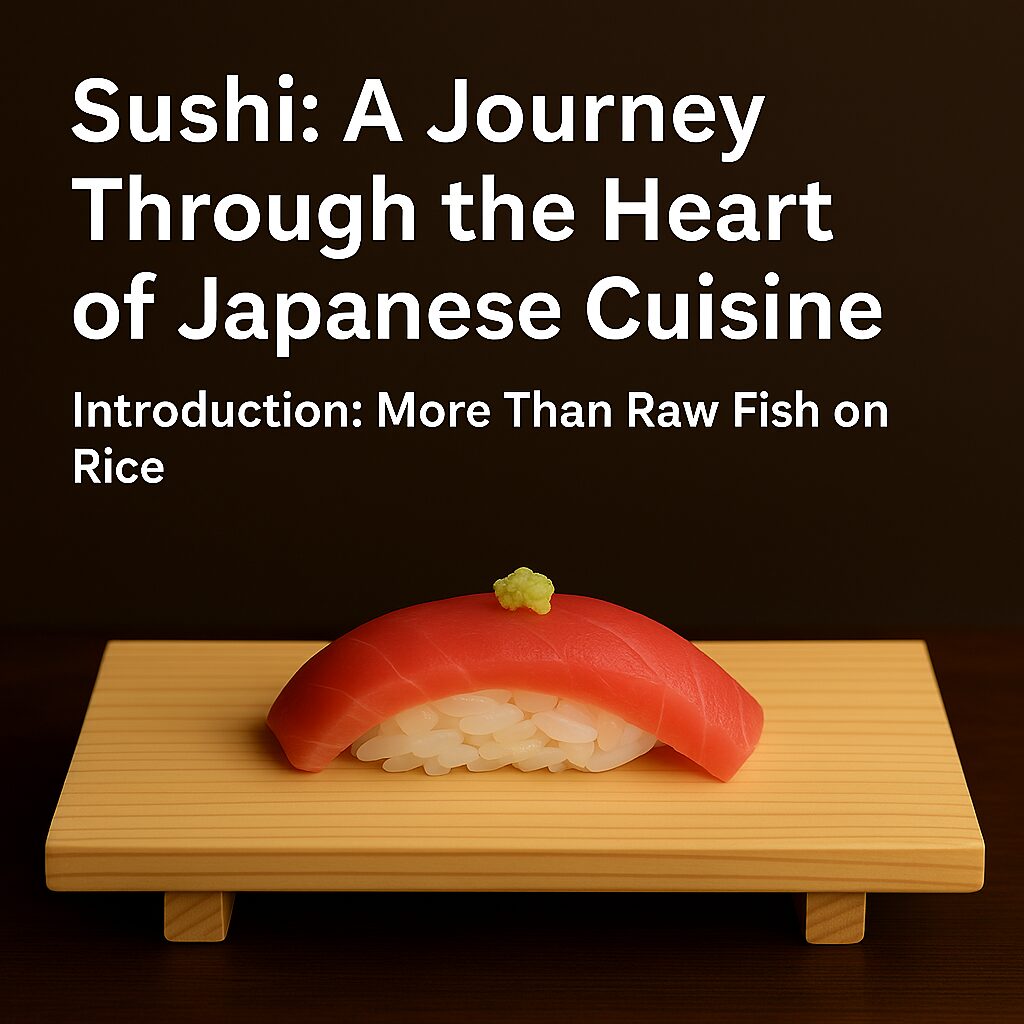✨ Introduction: More Than Raw Fish on Rice
When people around the world think of Japanese food, one word often comes to mind: sushi. From high-end omakase counters to conveyor belt chains, sushi has become a global icon of Japanese cuisine. But behind its elegant simplicity lies a rich and complex history—one that reflects the ingenuity, spirituality, and cultural depth of Japan itself.
🐟 Ancient Roots: Sushi as a Means of Survival
🍚 Narezushi and the Art of Fermentation
Long before sushi became a delicacy, it was a method of preservation. In the humid, pre-refrigeration world of ancient Japan, people developed narezushi—a technique of fermenting fish with rice to extend its shelf life. This practice dates back to the Jōmon period (14,000–300 BCE), making sushi one of the oldest continuously evolving food traditions in the world.
Famous examples like funazushi from Lake Biwa or sanma narezushi from Wakayama could be preserved for months or even years. These were not just meals—they were survival strategies, deeply tied to Japan’s geography and climate.
🧂 Cultural Controversies: Debunking the “Foreign Origin” Theory
Some modern scholars suggest that fermented sushi originated in Southeast Asia and was brought to Japan via China. But this theory overlooks key facts: inland regions like Yunnan or northern Thailand lack access to sea fish, and essential ingredients like nigari (used in tofu-making) require coastal salt production.
In contrast, Japan’s island geography, abundant seafood, and rice cultivation made it a natural cradle for fermentation-based cuisine. It’s far more plausible that narezushi developed independently in Japan, shaped by necessity and refined by culture.
🍣 Edo-Era Innovation: The Birth of Edomae Sushi
🏙️ Urban Appetite Meets Culinary Ingenuity
By the early 1800s, during the Bunka-Bunsei era of the Edo period, Tokyo (then Edo) was a bustling metropolis. Its fast-paced citizens had no time to wait for fermentation. Enter Edomae sushi—fresh fish placed atop vinegared rice, served immediately with wasabi and soy sauce.
This was sushi reimagined for the city: quick, flavorful, and portable. It was the original Japanese fast food, and it revolutionized urban dining.
🧠 The Vinegar Revolution
The key innovation was vinegar. In 1804, a sake brewer named Nakano Matazaemon from Handa (near Nagoya) began selling vinegar in Edo. He proposed a radical idea: skip fermentation and mix vinegar directly into freshly cooked rice. A sushi vendor named Hanaya Yohei embraced this concept and created the first nigiri-zushi—the hand-pressed sushi we know today.
This innovation made sushi faster, cheaper, and more accessible. It spread rapidly from Edo to Osaka, then across Japan. Nakano’s vinegar business? It became the company we now know as Mizkan.
🧘 The Spirit Behind the Taste
💓 Sushi Is Made with the Heart
In Japan, taste is not just about ingredients—it’s about intention. Sushi chefs (itamae) undergo years, even decades, of rigorous training. Not just to master knife skills or rice preparation, but to cultivate the right spirit. As the saying goes, “Flavor is created by the heart.”
That’s why two pieces of sushi made with the same fish and rice can taste completely different—depending on who made them, and how.
🍙 The Power of a Mother’s Onigiri
Ask any Japanese person what the best rice ball (onigiri) they’ve ever had is, and many will say: “The one my mother made for my school trip.” Why? Because love, care, and intention infuse food with something beyond flavor. Sushi, too, carries this invisible ingredient.
🌍 Sushi Goes Global: A Cultural Ambassador
✈️ From Edo to the World
In the late 20th century, sushi began its global journey. It first gained popularity in the United States, then spread to Europe, Southeast Asia, and beyond. Creative adaptations like the California Roll helped bridge cultural gaps, while traditional omakase experiences introduced global diners to the artistry of Japanese cuisine.
Today, sushi ranges from luxury dining to convenience store fare. But not all sushi is created equal. Some foreign-owned chains serve sushi that’s soggy, fishy, or flavorless. Why? Because sushi is not just a recipe—it’s a philosophy.
🧠 You Can Copy the Form, But Not the Soul
Without understanding the cultural depth, seasonal sensitivity, and spiritual discipline behind sushi, it becomes a hollow imitation. As Japanese cuisine expert Yoshihiro Murata once said, “You can copy the form, but not the soul.”
🎌 Sushi as a Cultural Gateway
Japanese culture is known for its accessibility at the surface and its profound depth underneath. Sushi is a perfect example. It welcomes newcomers with familiar flavors, but rewards the curious with layers of history, technique, and meaning.
To truly appreciate sushi is to begin a journey into the heart of Japan—its geography, its seasons, its aesthetics, and its values.
🌟 Conclusion: Sushi Is More Than Food
Sushi is not just something you eat. It’s something you feel. It’s a story of survival, innovation, and devotion. It’s a symbol of Japan’s ability to balance simplicity with sophistication, tradition with creativity.
So the next time you enjoy a piece of sushi, remember: you’re not just tasting fish and rice. You’re tasting centuries of culture, and the quiet strength of a people who believe that even the simplest things—when made with care—can become extraordinary.



コメント